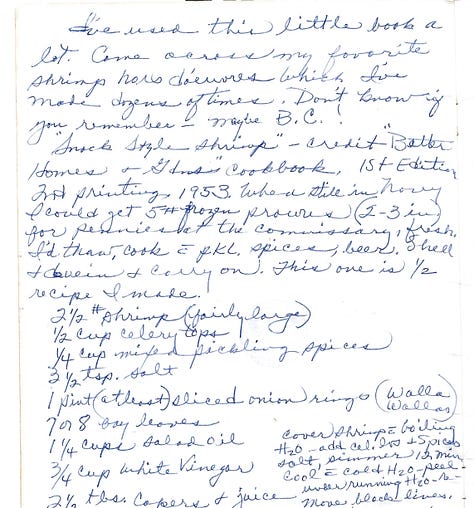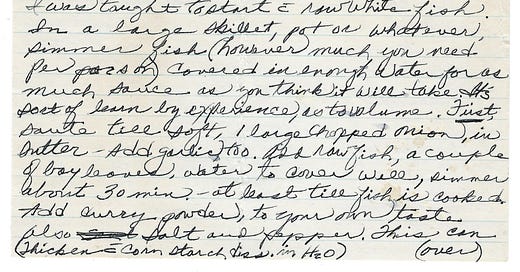“I was taught to start with raw white fish.”
So begins one of the more cherished among so many cherished recipes in the beat-up recipe folder of my mom’s.
That she chose to write that recipe as if speaking to me, talking me through the steps, it touches my heart every time I read those words. I can hear her, and see her in the kitchen, and remember the many times we had curry when I was a kid. It was particularly joyful to make this around the holidays a couple of years ago, reminiscing with my brother and sister who of course share those memories. (I’d love to know more about how this recipe became part of Mom’s repertoire. Though on a cookie recipe in her collection, she wrote that the “wife of Smitty taught me curry 1952 Falls Church VA”. Who Smitty and his wife were and their story behind the recipe? Among things I wish I’d asked my mom about.)
Traditionally-written recipes, with the familiar format of ingredient list followed by preparation steps, are traditional for a reason: they’re familiar and easy to follow. But it’s nice now and then to break with tradition.
Writing a recipe out in a more conversational way, as my mom did there, conveys a more personal connection with the person on the receiving end. It’s the beginning of a dialogue, a conversation continued every time that recipe is cooked. And these recipes can be a truer reflection of how the recipe is cooked by the person sharing it—so familiar and natural that no ingredient list is needed, no recipe card referenced for reminders.
This approach is more “this is how I make xxxx” than “here’s a recipe for xxxx.”
As a food writer who has written hundreds of recipes for cookbooks and other projects, I pretty much always go with the traditional style. It’s what best suits the work I typically do. But in a newsletter, I’ll gladly dispense with that formality on occasion. Especially when I want to convey the ease or freedom with which a dish came together—carrying someone else along on my cooking-off-the-cuff journey. A less formal recipe style reflects that well, rather than transcribing a natural flow of cooking into a formalized recipe structure.
My other newsletter, Seafood Savvy, has a goal of sharing my love of seafood, usually with a recipe or two for some direct, get-in-the-kitchen inspiration. Now and then, to demonstrate the potential for ease and freedom that I so appreciate when cooking seafood, I’ll present an informal recipe. Instead of an ingredient list followed by steps for making the recipe, I walk the reader through what I did on that occasion. One of the points being: that’s how I happened to cook it that one time, and next time I’ll probably do it differently, so why lock it down in a formal recipe? It’s a nudge for readers to be a little more comfortable with winging it.
Here’s one such example, Marinated Mussels with Fennel.
And here’s one from a long-ago blog post about my love of gribiche sauce, recounting what I’d made for dinner the night before:
I hard-cooked 2 eggs and grated them through the large holes on my box grater into a large bowl. I then used the same grater holes to grate/shred a dozen or so cornichons. (I really love that piquant, vinegary character of cornichons, but a good pickle can do the trick.)
Chopped a few tablespoons of capers, added them to the bowl with a tablespoon or so of Dijon mustard, a good glug (1/4 cup perhaps?) of white wine vinegar and about the same of olive oil. Tossed in a good dose of chopped chives from the garden as well; would have added parsley but mine bolted in the past week or two. Salt, pepper, whip it all together.
I let it just sit there and get all delicious while I broke up a head of cauliflower into small florets and steamed them just until nearly tender. While still warm, I added the cauliflower to the gribiche, stirred it around gently with a large spatula to evenly coat the cauliflower with the sauce, and let cool just a bit before serving. I find the flavors more balanced and enjoyable when warm at the most. In fact, I’m having a bowl of the cold leftover cauliflower today for lunch and it’s great at that temp as well.
I would call my mom’s version of how she made fish curry (or the shrimp and chicken versions she briefly mentions on the back) an informal recipe as well. Though that particular recipe is kind of hilariously non-specific with a lot of the details…amount of fish is “however much you need” and the amount of water added equally vague. So it also serves as a fabulous example of a recipe where “filling the gaps” comes into play. It makes for a great show-and-tell in my workshops!
Below is a slightly different example, my mom sharing a recipe from one of her cookbooks, writing it for me on the inside cover of a 1968 booklet of shellfish recipes from the Washington Department of Fisheries. Her intro to the recipe has that personal touch that makes it so special, something I treasure beyond simply having that recipe she made so often. That I would later write my own shellfish cookbook? Mom, nor I, could have had any idea, of course. It made me so very happy to include this recipe, and the story of this memento, in that cookbook a couple of years ago. “Shell and devein and carry on,” she says.
Thanks, Mom. I’ll do just that.







